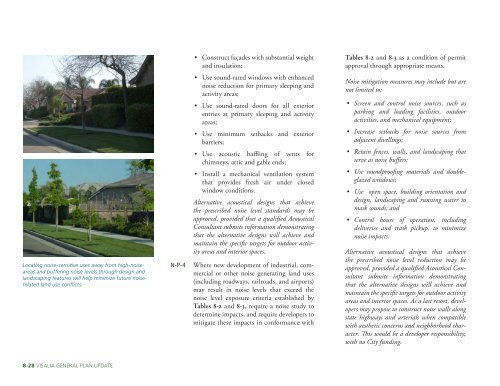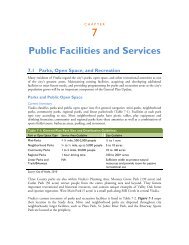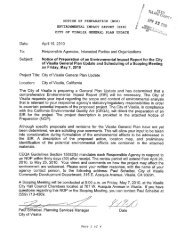General Plan Update Review Committee Draft Elements Part 2 For ...
General Plan Update Review Committee Draft Elements Part 2 For ...
General Plan Update Review Committee Draft Elements Part 2 For ...
Create successful ePaper yourself
Turn your PDF publications into a flip-book with our unique Google optimized e-Paper software.
Locating noise-sensitive uses away from high-noise<br />
areas and buffering noise levels through design and<br />
landscaping features will help minimize future noiserelated<br />
land use conflicts.<br />
8-28 VISALIA GENERAL PLAN UPDATE<br />
• Construct façades with substantial weight<br />
and insulation;<br />
• Use sound-rated windows with enhanced<br />
noise reduction for primary sleeping and<br />
activity areas;<br />
• Use sound-rated doors for all exterior<br />
entries at primary sleeping and activity<br />
areas;<br />
• Use minimum setbacks and exterior<br />
barriers;<br />
• Use acoustic baffling of vents for<br />
chimneys, attic and gable ends;<br />
• Install a mechanical ventilation system<br />
that provides fresh air under closed<br />
window conditions.<br />
Alternative acoustical designs that achieve<br />
the prescribed noise level standards may be<br />
approved, provided that a qualified Acoustical<br />
Consultant submits information demonstrating<br />
that the alternative designs will achieve and<br />
maintain the specific targets for outdoor activity<br />
areas and interior spaces.<br />
N-P-4 Where new development of industrial, commercial<br />
or other noise generating land uses<br />
(including roadways, railroads, and airports)<br />
may result in noise levels that exceed the<br />
noise level exposure criteria established by<br />
Tables 8-2 and 8-3, require a noise study to<br />
determine impacts, and require developers to<br />
mitigate these impacts in conformance with<br />
Tables 8-2 and 8-3 as a condition of permit<br />
approval through appropriate means.<br />
Noise mitigation measures may include but are<br />
not limited to:<br />
• Screen and control noise sources, such as<br />
parking and loading facilities, outdoor<br />
activities, and mechanical equipment;<br />
• Increase setbacks for noise sources from<br />
adjacent dwellings;<br />
• Retain fences, walls, and landscaping that<br />
serve as noise buffers;<br />
• Use soundproofing materials and doubleglazed<br />
windows;<br />
• Use open space, building orientation and<br />
design, landscaping and running water to<br />
mask sounds; and<br />
• Control hours of operation, including<br />
deliveries and trash pickup, to minimize<br />
noise impacts.<br />
Alternative acoustical designs that achieve<br />
the prescribed noise level reduction may be<br />
approved, provided a qualified Acoustical Consultant<br />
submits information demonstrating<br />
that the alternative designs will achieve and<br />
maintain the specific targets for outdoor activity<br />
areas and interior spaces. As a last resort, developers<br />
may propose to construct noise walls along<br />
state highways and arterials when compatible<br />
with aesthetic concerns and neighborhood character.<br />
This would be a developer responsibility,<br />
with no City funding.




